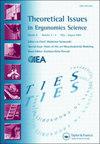Developing a Bayesian network model for improving chemical plant workers’ situation awareness
IF 1.4
Q4 ERGONOMICS
引用次数: 1
Abstract
Abstract The present study aimed to create a Bayesian network (BN) model to manage and improve workers’ situation awareness. The 12 important variables affecting workers’ situation awareness were determined using the Fuzzy Delphi method and experts’ opinions. The data were collected using a self-administered questionnaire. The BN model was created using the Dempster-Shafer theory. The expectation-maximization algorithm was employed to determine the conditional probability tables. Belief updating was utilized to determine the variables with the strongest effects on situation awareness. Based on performance evaluation criteria of the BN model, the model performance was acceptable. Environmental distraction, safety knowledge, and fatigue were the best predictors of situation awareness. Furthermore, it was found that decreasing environmental distraction and work pressure, and improving safety knowledge were the best intervention strategies to improve workers’ situation awareness. Overall, we can conclude that the BN model is a powerful tool to create a causal model. Moreover, using belief updating as an exclusive characteristic of BN enables managers to select the best intervention strategies. The results of this study provide a basis for managers’ decision-making to improve employee safety performance in the workplaces and the proposed model can potentially be used for employee safety performance.建立贝叶斯网络模型提高化工厂工人的情境意识
摘要本研究旨在创建一个贝叶斯网络(BN)模型来管理和提高工人的情境意识。运用模糊德尔菲法和专家意见,确定了影响工人情境意识的12个重要变量。这些数据是通过自我管理问卷收集的。BN模型是使用Dempster-Shafer理论创建的。采用期望最大化算法确定条件概率表。信念更新被用来确定对情境意识影响最大的变量。根据BN模型的性能评估标准,模型性能可以接受。环境干扰、安全知识和疲劳是情境意识的最佳预测因素。此外,研究发现,减少环境干扰和工作压力,提高安全知识是提高工人情境意识的最佳干预策略。总的来说,我们可以得出结论,BN模型是创建因果模型的有力工具。此外,将信念更新作为BN的独有特征,使管理者能够选择最佳的干预策略。本研究的结果为管理者提高员工在工作场所的安全绩效提供了决策依据,所提出的模型有可能用于员工的安全绩效。
本文章由计算机程序翻译,如有差异,请以英文原文为准。
求助全文
约1分钟内获得全文
求助全文

 求助内容:
求助内容: 应助结果提醒方式:
应助结果提醒方式:


